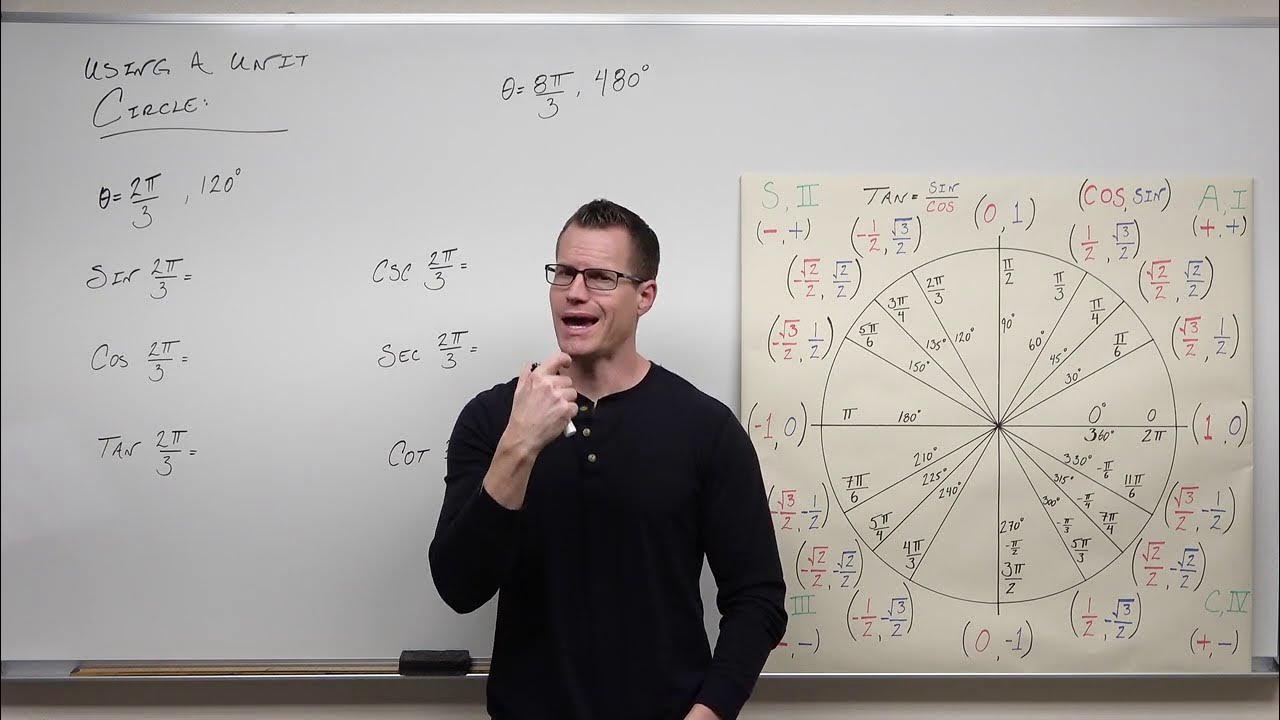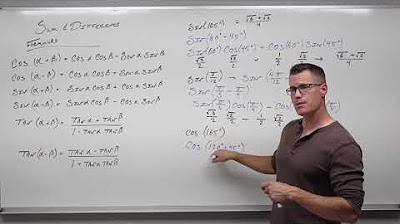Introduction to Angles (Precalculus - Trigonometry 1)
TLDRThis engaging video script introduces viewers to the fascinating world of trigonometry, emphasizing its relevance and utility in making calculus more approachable. The presenter dives into the fundamentals, explaining the concept of angles, their measurement in both degrees and radians, and the importance of understanding these units for grasping trigonometric functions. The video outlines the process of measuring angles in standard position, the significance of quadrants, and how angles can be positive or negative based on the direction of rotation. With practical examples and clear illustrations, the script aims to solidify the viewer's understanding of angles before delving into more complex topics, setting a strong foundation for further mathematical exploration.
Takeaways
- 📐 **Understanding Angles**: Angles are formed by two rays sharing a common starting point, known as the vertex.
- ⚙️ **Standard Position**: Angles are typically drawn with the initial side on the positive x-axis and measured counterclockwise for positive angles and clockwise for negative angles.
- 🔄 **Degrees and Rotation**: A full rotation is 360 degrees. Angles can be measured in degrees, with each degree representing 1/360th of a rotation.
- 📉 **Quadrants and Quadrant Angles**: Angles can end in different quadrants (I, II, III, IV) and are named quadrant angles (90, 180, 270, 360 degrees) when they terminate on an axis.
- 🔢 **Positive and Negative Angles**: Positive angles are measured counterclockwise, while negative angles are measured clockwise from the initial side.
- 🌀 **Direction of Angles**: The direction of angle measurement is crucial as it determines whether an angle is positive or negative.
- 📏 **Radian Measure**: Radians are another way to measure angles, and they are important for calculus and many trigonometric functions.
- 🔴 **Unit Circle**: The unit circle is a circle with a radius of one, centered at the origin, and is used to relate angles to their trigonometric function values.
- 🔸 **Theta and Other Greek Letters**: Greek letters such as theta (θ), alpha (α), and beta (β) are commonly used to represent angles in trigonometry.
- 🔳 **Zero and Full Rotation Angles**: An angle of zero degrees or 360 degrees represents no rotation, while a full rotation is 360 degrees, which can also be represented as 0 degrees after a complete circle.
- 🔁 **Multiple Rotations**: Angles greater than 360 degrees represent multiple full rotations plus an additional angle, which can be found by subtracting full rotations (360 degrees) from the given angle.
Q & A
What is trigonometry and why is it considered useful?
-Trigonometry is a branch of mathematics that deals with the relationships between the angles and sides of triangles. It is considered useful because it has practical applications in various fields such as physics, engineering, and even in everyday calculations involving lengths and angles.
What is the significance of the unit circle in trigonometry?
-The unit circle is a circle with a radius of 1 and is centered at the origin of the coordinate plane. It is significant in trigonometry because it provides a way to define the trigonometric functions (sine, cosine, and tangent) in terms of angles measured in radians.
How is an angle defined in the context of trigonometry?
-In trigonometry, an angle is defined as the figure formed by two rays (or line segments) sharing a common endpoint, known as the vertex. The size of the angle depends on the amount of rotation from one ray to the other.
What are the two common units used to measure angles and how are they related?
-The two common units used to measure angles are degrees and radians. A full circle is 360 degrees or 2π radians. To convert between them, one can use the fact that 180 degrees is equivalent to π radians.
What is a standard position for an angle and what are the initial and terminal sides?
-A standard position for an angle is when the vertex of the angle is at the origin and the initial side lies along the positive x-axis. The terminal side is where the angle ends after rotation, and the angle is measured from the initial side to the terminal side, counterclockwise for positive angles and clockwise for negative angles.
What are quadrant angles and how are they defined?
-Quadrant angles are the angles that terminate on the coordinate axes. They are defined as 0° (or 360°), 90°, 180°, 270°, and 360°, corresponding to the points where the terminal side of the angle lies along the x-axis or y-axis after a full rotation or a fraction of it.
What is the difference between measuring angles in a clockwise direction versus a counterclockwise direction?
-Measuring angles in a counterclockwise direction is considered positive, while measuring angles in a clockwise direction is considered negative. This convention is important in trigonometry as it determines the sign of the angle's measure.
What is the relationship between a full rotation and the degree measure of an angle?
-A full rotation is equivalent to 360 degrees. Therefore, any angle measure can be understood as a fraction of a full rotation. For example, a 90-degree angle is one-fourth of a full rotation.
How do you determine the quadrant in which an angle terminates?
-To determine the quadrant in which an angle terminates, you start with the angle in standard position and measure the angle from the initial side (positive x-axis) either counterclockwise (positive angle) or clockwise (negative angle) until you reach the terminal side. The quadrant is then identified based on the position of the terminal side relative to the coordinate axes.
What is the significance of the angle measure of 45 degrees in a standard position?
-An angle of 45 degrees in standard position does not terminate on any of the axes, placing it within a quadrant. Specifically, it bisects the first quadrant, lying on the line where y equals x, starting from the origin.
How can you convert between degrees and radians when measuring angles?
-To convert from degrees to radians, multiply the degree measure by π/180. To convert from radians to degrees, multiply the radian measure by 180/π. These conversions are based on the fact that 180 degrees is equivalent to π radians.
Outlines
📚 Introduction to Trigonometry and Angles
The video begins with an introduction to trigonometry, emphasizing its importance and practicality. It explains that a good understanding of trigonometry is essential for grasping calculus. The focus is on angles, their definitions, and the concept of standard position. The video outlines the plan to discuss degrees and radians, their conversion, real-life examples, and the unit circle, which is a fundamental tool in mathematics.
🔍 Exploring Degrees, Radians, and Quadrants
This paragraph delves into the measurement of angles using degrees and radians. It explains the concept of a full rotation being 360 degrees and introduces the idea of quadrants, which divide a standard position circle into four equal parts, each representing a 90-degree angle. The video also touches on the representation of angles using Greek letters like theta and the importance of the direction of measurement, highlighting positive (counterclockwise) and negative (clockwise) angles.
📐 Understanding Angles in Standard Position
The video continues by discussing angles in standard position, explaining how angles are measured from the initial side on the x-axis to the terminal side, either positively (counterclockwise) or negatively (clockwise). It emphasizes the importance of accurate measurement and understanding of angles before proceeding to more complex topics. The concept of quadrant angles (90, 180, 270, and 360 degrees) is introduced, along with the idea that angles can be represented as zero degrees when the initial and terminal sides overlap.
🤔 Positive and Negative Angles in Quadrants
This section focuses on identifying angles by their initial and terminal sides, the direction of rotation (positive or negative), and their location within the quadrants. The video provides examples of how to measure angles like 45 degrees, -30 degrees, and 225 degrees, explaining how to visualize their positions in the coordinate plane. It also invites viewers to consider how the same angle can be represented both positively and negatively, leading to the same terminal side but with different rotational directions.
🔁 Rotations and Terminal Sides
The video script elaborates on angles that exceed a full rotation, such as 405 and -540 degrees. It demonstrates how to calculate and visualize these angles, which involve spinning around the coordinate plane more than once. The key takeaway is that regardless of whether an angle is measured positively or negatively, the terminal side can be the same, although the number of rotations and the direction will differ. This concept is crucial for understanding trigonometric functions and their applications.
🕒 Minutes and Seconds in Angle Measurement
The final paragraph teases the next topic to be covered in the series: minutes and seconds as subdivisions of a degree. It draws an analogy with time measurement, where 60 seconds make a minute and 60 minutes make an hour. The video promises to explain how to convert between degrees, minutes, and seconds, which is another fundamental aspect of angular measurement in trigonometry.
Mindmap
Keywords
💡Trigonometry
💡Angles
💡Degrees
💡Radians
💡Unit Circle
💡Quadrants
💡Standard Position
💡Initial Side and Terminal Side
💡Counterclockwise and Clockwise Rotation
💡Quadrant Angles
💡Reference Angles
Highlights
Trigonometry is introduced as a fun and useful subject that makes calculus easier.
Angles are formed by two rays sharing a common starting point, known as a vertex.
A standard position for angles is when the initial side lies on the x-axis and the angle is measured counterclockwise.
All angles are measured positively when moving counterclockwise and negatively when moving clockwise.
The concept of a full rotation being 360 degrees is explained.
Quadrant angles (90, 180, 270, 360 degrees) are introduced as angles that terminate on the axes.
The importance of the degree symbol in indicating the type of angle measurement is emphasized.
Radians are mentioned as an alternative measurement to degrees, crucial for many trigonometric formulas.
Explains that an angle of zero degrees or radians can exist even when two rays overlap, pointing in the same direction.
The unit circle is mentioned as a fundamental tool in trigonometry that will be used extensively.
The Greek letter theta is commonly used to represent angles in trigonometric notation.
Angles can be named using various Greek letters such as alpha, beta, and theta.
The concept of reference angles and how they relate to the quadrants is introduced.
Explains that angles can terminate in quadrants, which are numbered and relate to the direction of rotation.
Practicing with various angles helps solidify understanding of their measurements and relationships to quadrants.
Positive and negative angles can result in the same terminal side but represent different rotations.
The video concludes with a teaser for the next topic: minutes and seconds in terms of degrees.
Transcripts
Browse More Related Video

Trig 0.1 - Angles, Degrees and Radians

Trigonometry: How to use the ASTC Rule | The Quadrant | CAST

Calculus 1 Lecture 0.3: Review of Trigonometry and Graphing Trigonometric Functions

ANGLES IN A UNIT CIRCLE || PRE-CALCULUS

How to Use the Unit Circle in Trigonometry (Precalculus - Trigonometry 7)

Introduction to Sum and Difference Formulas in Trigonometry (Precalculus - Trigonometry 25)
5.0 / 5 (0 votes)
Thanks for rating: